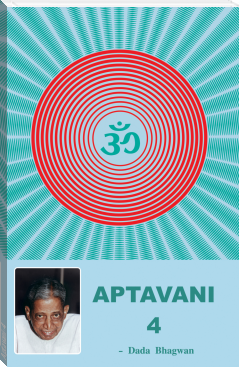The Yoga Sutras of Patanjali by Patañjali (color ebook reader .txt) 📖

- Author: Patañjali
- Performer: -
Book online «The Yoga Sutras of Patanjali by Patañjali (color ebook reader .txt) 📖». Author Patañjali
Or a comet, unheralded, appears in the sky like a flaming sword. The beholder is at first astonished, perhaps terror-stricken; but he takes himself in hand, controls his thoughts, views the apparition calmly, and finally calculates its orbit and its relation to meteor showers.
These are extreme illustrations; but with all knowledge the order of perception is the same: first, the excitation of the mind by the new object impressed on it; then the control of the mind from within; upon which follows the perception of the nature of the object. Where the eyes of the spiritual man are open, this will be a true and penetrating spiritual perception. In some such way do our living experiences come to us; first, with a shock of pain; then the Soul steadies itself and controls the pain; then the spirit perceives the lesson of the event, and its bearing upon the progressive revelation of life.
10. Through frequent repetition of this process, the mind becomes habituated to it, and there arises an equable flow of perceiving consciousness.
Control of the mind by the Soul, like control of the muscles by the mind, comes by practice, and constant voluntary repetition.
As an example of control of the muscles by the mind, take the ceaseless practice by which a musician gains mastery over his instrument, or a fencer gains skill with a rapier. Innumerable small efforts of attention will make a result which seems well-nigh miraculous; which, for the novice, is really miraculous. Then consider that far more wonderful instrument, the perceiving mind, played on by that fine musician, the Soul. Here again, innumerable small efforts of attention will accumulate into mastery, and a mastery worth winning. For a concrete example, take the gradual conquest of each day, the effort to live that day for the Soul. To him that is faithful unto death, the Master gives the crown of life.
11. The gradual conquest of the mind’s tendency to flit from one object to another, and the power of onepointedness, make the development of Contemplation.
As an illustration of the mind’s tendency to flit from one object to another, take a small boy, learning arithmetic. He begins: two ones are two; three ones are three-and then he thinks of three coins in his pocket, which will purchase so much candy, in the store down the street, next to the toy-shop, where are base-balls, marbles and so on,—and then he comes back with a jerk, to four ones are four. So with us also. We are seeking the meaning of our task, but the mind takes advantage of a moment of slackened attention, and flits off from one frivolous detail to another, till we suddenly come back to consciousness after traversing leagues of space. We must learn to conquer this, and to go back within ourselves into the beam of perceiving consciousness itself, which is a beam of the Oversoul. This is the true onepointedness, the bringing of our consciousness to a focus in the Soul.
12. When, following this, the controlled manifold tendency and the aroused onepointedness are equally balanced parts of the perceiving consciousness, his the development of onepointedness.
This would seem to mean that the insight which is called onepointedness has two sides, equally balanced. There is, first, the manifold aspect of any object, the sum of all its characteristics and properties. This is to be held firmly in the mind. Then there is the perception of the object as a unity, as a whole, the perception of its essence. First, the details must be clearly perceived; then the essence must be comprehended. When the two processes are equally balanced, the true onepointedness is attained. Everything has these two sides, the side of difference and the side of unity; there is the individual and there is the genus; the pole of matter and diversity, and the pole of oneness and spirit. To see the object truly, we must see both.
13. Through this, the inherent character, distinctive marks and conditions of being and powers, according to their development, are made clear.
By the power defined in the preceding sutra, the inherent character, distinctive marks and conditions of beings and powers are made clear. For through this power, as defined, we get a twofold view of each object, seeing at once all its individual characteristics and its essential character, species and genus; we see it in relation to itself, and in relation to the Eternal. Thus we see a rose as that particular flower, with its colour and scent, its peculiar fold of each petal; but we also see in it the species, the family to which it belongs, with its relation to all plants, to all life, to Life itself. So in any day, we see events and circumstances; we also see in it the lesson set for the soul by the Eternal.
14. Every object has its characteristics which are already quiescent, those which are active, and those which are not yet definable.
Every object has characteristics belonging to its past, its present and its future. In a fir tree, for example, there are the stumps or scars of dead branches, which once represented its foremost growth; there are the branches with their needles spread out to the air; there are the buds at the end of each branch and twig, which carry the still closely packed needles which are the promise of the future. In like manner, the chrysalis has, as its past, the caterpillar; as its future, the butterfly. The man has, in his past, the animal; in his future, the angel. Both are visible even now in his face. So with all things, for all things change and grow.
15. Difference in stage is the cause of difference in development.
This but amplifies what has just been said. The first stage is the sapling, the caterpillar, the animal. The second stage is the growing tree, the chrysalis, the man. The third is the splendid pine, the butterfly, the angel. Difference of stage is the cause of difference of development. So it is among men, and among the races of men.
16. Through perfectly concentrated Meditation on the three stages of development comes a knowledge of past and future.
We have taken our illustrations from natural science, because, since every true discovery in natural science is a divination of a law in nature, attained through a flash of genius, such discoveries really represent acts of spiritual perception, acts of perception by the spiritual man, even though they are generally not so recognized. So we may once more use the same illustration. Perfectly concentrated Meditation, perfect insight into the chrysalis, reveals the caterpillar that it has been, the butterfly that it is destined to be. He who knows the seed, knows the seed-pod or ear it has come from, and the plant that is to come from it. So in like manner he who really knows today, and the heart of to-day, knows its parent yesterday and its child tomorrow. Past, present and future are all in the Eternal. He who dwells in the Eternal knows all three.
17. The sound and the object and the thought called up by a word are confounded because they are all blurred together in the mind. By perfectly concentrated Meditation on the distinction between them, there comes an understanding of the sounds uttered by all beings.
It must be remembered that we are speaking of perception by the spiritual man.
Sound, like every force, is the expression of a power of the Eternal. Infinite shades of this power are expressed in the infinitely varied tones of sound. He who, having entry to the consciousness of the Eternal knows the essence of this power, can divine the meanings of all sounds, from the voice of the insect to the music of the spheres.
In like manner, he who has attained to spiritual vision can perceive the mind-images in the thoughts of others, with the shade of feeling which goes with them, thus reading their thoughts as easily as he hears their words. Every one has the germ of this power, since difference of tone will give widely differing meanings to the same words, meanings which are intuitively perceived by everyone.
18. When the mind-impressions become visible, there comes an understanding of previous births.
This is simple enough if we grasp the truth of rebirth. The fine harvest of past experiences is drawn into the spiritual nature, forming, indeed, the basis of its development. When the consciousness has been raised to a point above these fine subjective impressions, and can look down upon them from above, this will in itself be a remembering of past births.
19. By perfectly concentrated Meditation on mind-images is gained the understanding of the thoughts of others.
Here, for those who can profit by it, is the secret of thought-reading. Take the simplest case of intentional thought transference. It is the testimony of those who have done this, that the perceiving mind must be stilled, before the mind-image projected by the other mind can be seen. With it comes a sense of the feeling and temper of the other mind and so on, in higher degrees.
20. But since that on which the thought in the mind of another rests is not objective to the thought-reader’s consciousness, he perceives the thought only, and not also that on which the thought rests.
The meaning appears to be simple: One may be able to perceive the thoughts of some one at a distance; one cannot, by that means alone, also perceive the external surroundings of that person, which arouse these thoughts.
21. By perfectly concentrated Meditation on the form of the body, by arresting the body’s perceptibility, and by inhibiting the eye’s power of sight, there comes the power to make the body invisible.
There are many instances of the exercise of this power, by mesmerists, hypnotists and the like; and we may simply call it an instance of the power of suggestion. Shankara tells us that by this power the popular magicians of the East perform their wonders, working on the mind-images of others, while remaining invisible themselves. It is all a question of being able to see and control the mind-images.
22. The works which fill out the life-span may be either immediately or gradually operative. By perfectly concentrated Meditation on these comes a knowledge of the time of the end, as also through signs.
A garment which is wet, says the commentator, may be hung up to dry, and so dry rapidly, or it may be rolled in a ball and dry slowly; so a fire may blaze or smoulder. Thus it is with Karma, the works that fill out the life-span. By an insight into the mental forms and forces which make up Karma, there comes a knowledge of the rapidity or slowness of their development, and of the time when the debt will be paid.
23. By perfectly concentrated Meditation on sympathy, compassion and kindness, is gained the power of interior union with others.
Unity is the reality; separateness the illusion. The nearer we come to reality, the nearer we come to unity of heart. Sympathy, compassion, kindness are modes of this unity of heart, whereby we rejoice with those who rejoice, and weep with those who weep. These things are learned by desiring to learn them.
24. By perfectly concentrated Meditation on power, even such power as that of the elephant may be gained.
This is a pretty image. Elephants possess not only force, but poise and fineness of control. They can lift a straw, a





Comments (0)